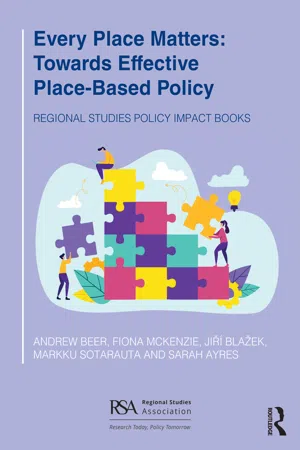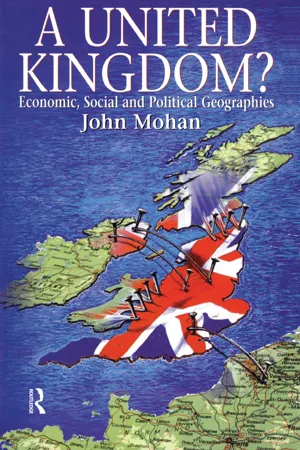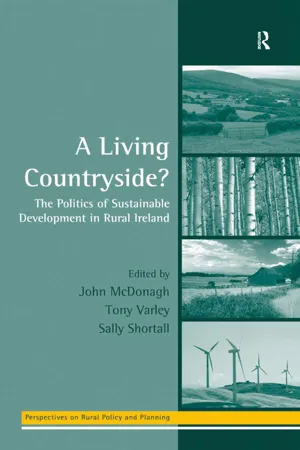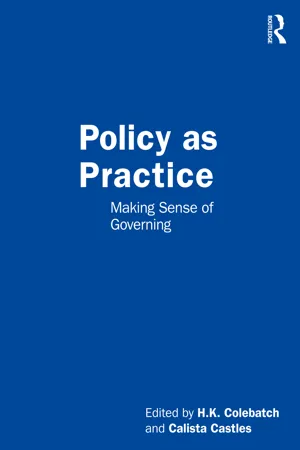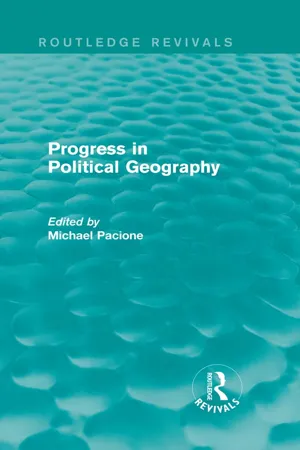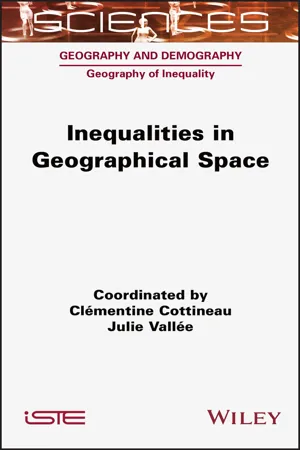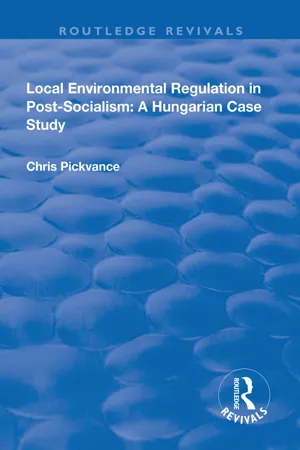Geography
Local Government Policies
Local government policies refer to the regulations and guidelines implemented by local authorities to manage and govern their respective areas. These policies address a wide range of issues, including land use, zoning, public services, and environmental protection. They are designed to address the specific needs and challenges of a particular locality, and they play a crucial role in shaping the physical and social landscape of a region.
Written by Perlego with AI-assistance
Related key terms
7 Key excerpts on "Local Government Policies"
- eBook - ePub
Every Place Matters
Towards Effective Place-Based Policy
- Andrew Beer, Fiona McKenzie, Jiří Blažek, Markku Sotarauta, Sarah Ayres(Authors)
- 2020(Publication Date)
- Routledge(Publisher)
In the 21st century, the engagement in and contribution of various stakeholders is common to the policy-formation process, including community groups, higher education institutions and private sector actors. However, public policies remain primarily the domain of governments because they are made in the public’s name, thus bringing the role and authority of government into sharp relief. 25 Policies are generally formulated or initiated by a government, even in cases with extensive participation of various societal groups. Importantly, a policy is not only what the government intends to do but also what it decides not to do. Place-based policies assume that geography truly matters. Barca et al. 26 argued that local/regional development strategies should not be spatially blind and thus indifferent to the specificities of places, indifferent to geography. Moreover, space-neutral policies are never as neutral as assumed by their advocates; policies always have – intended or not – spatial effects. Place-based policies recognise that the institutions embedded within places, as well as locally embedded knowledge and action, are the appropriate cornerstones upon which to build local prosperity. As Bailey et al. 27 contended, there is a need for ‘an integrative approach, with a mix of appropriate inclusive policies across a range of policy domains, reflecting the desired and aimed-for competitive advantage of regions’. Jessop 28 has argued that the territorial organisation of political authority is the essential feature of modern statehood. It has different forms and rests on specific political, economic and relational attributes that result in different kinds of place-based governance arenas and leadership potentials. 29 He suggests that regions serve as policy laboratories for experimentation in government and governance, and these experiments have implications for redesigning institutions, policies and politics in response to policy failures and other crises - eBook - ePub
A United Kingdom?
Economic, Social and Political Geographies
- John Mohan(Author)
- 2014(Publication Date)
- Routledge(Publisher)
12 MANAGING UNEVEN DEVELOPMENT PHILOSOPHIES, POLICIES AND IMPACTS12.1 INTRODUCTIONInitially conceived as temporary and limited expedients, introduced in response to the severity of the inter-war depression, regional policies have become an enduring feature of the UK’s political geography. Though not large in terms of public expenditure, their ideological and political significance is disproportionate since they are a key index both of state commitment to less prosperous places, and of the extent to which – and the ways in which – governments have been willing to interfere with the natural operation of market forces (Lewis, 1984). Regional policy is a terrain, therefore, on which competing ideologies vie for supremacy. However, policy changes are not determined purely by ideological shifts, and external events – notably, the diverse impacts of globalisation – have influenced the scope and character of policy. One also has to consider a range of criticisms of the philosophical basis and practical application of spatial policy.Thus, whereas some form of spatial policy appeared to form part of Keynesian demand-management strategies for many years, the persistence of ‘regional’ problems, and the failures of Keynesianism itself, eventually undermined faith in the capacity of such demand management to ‘solve’ economic and social problems. Combined with some far-reaching critiques of regional policy’s instruments, this created the space within which the Conservatives were able substantially to retract the geographical extent, scope and modus operandi - eBook - ePub
A Living Countryside?
The Politics of Sustainable Development in Rural Ireland
- Tony Varley, John McDonagh, John McDonagh(Authors)
- 2016(Publication Date)
- Routledge(Publisher)
Owen 1996 ) suggests that planners often favour restraint policies for rural settlement planning as a selective interpretation of what constitutes sustainable planning practice. In these cases, restrictive rural planning policies with goals such as reducing car dependency and landscape protection are often promoted rather than policies which are aimed at diversifying the economic base of rural areas or sustaining rural communities.How these broad policy goals (and the mediation of policy objectives that are potentially conflicting) are translated into local authority development plans will therefore have profound effects on planning policies for rural areas, suggesting the need for enhanced understanding of the inter-relationships between economic, social and environmental processes within rural localities. The remainder of this chapter aims to review recent policy developments by ‘unpacking’ the RDS and the NSS and assessing the implications for the formulation of rural planning policies on three aspects of rural planning: (1) a spatially differentiated rural policy; (2) the conceptualization of the urban-rural relationship; and (3) accommodating housing in the countryside.Towards a spatially differentiated rural policy?
A significant development in both spatial strategies is the recognition that rural areas are not homogenous spaces, but are increasingly characterized by diverse development and community contexts, suggesting the need for spatially differentiated rural policies. For example, the RDS for Northern Ireland outlines contrasting development pressures between the Belfast travel-to-work area and the rest of the region, resulting in a suite of policy measures that support the revitalization of declining settlements, while also adopting growth management policies for rapidly expanding small towns and villages. - eBook - ePub
Policy as Practice
Making Sense of Governing
- H.K. Colebatch, Calista Castles, H.K. Colebatch, Calista Castles(Authors)
- 2023(Publication Date)
- Routledge(Publisher)
4 Local governments as policy shapers Sarah de VriesDOI: 10.4324/9781003368564-4Introduction
In an era where the need for community engagement in policymaking is almost universally recognised, local governments are uniquely positioned to contribute towards that goal (Herriman 2011 ). While critics attempt to portray the role of local governments as limited to service provision, or ‘roads, rates and rubbish’, it is well established that local governments’ remit is much broader and includes important aspects of social and environmental policy (Dollery, Wallis, and Allan 2006 ; Arnold and Long 2019 ). The principle of subsidiarity – that central governments should perform tasks which cannot be performed at a more local level – reinforces the importance of local governments for enabling effective cooperative governance (Dovers and Hussey 2013 ). In attempting to conceptualise the policymaking process, the ‘policy cycle’ as it is traditionally represented, mirrors the design process – with stages to facilitate problem framing, design, implementation, and continual improvement – but it is largely silent on who is included and excluded from the process. Legitimate and effective policy formation must be a highly collaborative process, including those who might be impacted by a particular policy and cognisant of the values of the broader community. Local governments have unique responsibilities and decision-making powers through their planning systems and proximity to the communities they serve. They are, though, nested within a multilevel governance system whose success relies on high levels of coordination and deliberation (Daniell and Adrian 2018 ). The empowerment – or otherwise – of local governments to influence other levels of government in that system is, therefore, crucial.Climate change and related environmental policies are a particularly illustrative example of local government involvement in policymaking beyond their legal remit. Local governments in Australia engage in environment-related activities well beyond their statutory requirements and in ways that are creative and innovative (Thomas 2010 ). Environmental matters are inextricably linked to the core business of local governments such as town planning, water and waste management as well as emerging areas of importance such as biodiversity, natural resource management, and energy use (Dollery, Wallis, and Allan 2006 - Michael Pacione(Author)
- 2014(Publication Date)
- Routledge(Publisher)
5 LOCAL GOVERNMENT AND THE STATE R.J. JohnstonA system of local governments is characteristic of most states. Each local government provides services for the population of a defined territory, raises at least some of its revenue from the residents and/or land users within that territory, and is accountable to others — to the central government that provides the legislative framework within which local governments operate and, in many cases, to the electorate within its territory. Because of the accountability, within any system there are both common elements and differences; local governments exist to perform certain functions, but interpret their roles differently because of variations in the constituency served.There is no substantial tradition of work on local government by geographers — in part because of the relatively low level of interest in political geography and the focus of the few political geographers on the larger-scale spatial phenomenon of the nation-state. There has been some interest in the definition of local government boundaries — stretching back to Fawcett’s (1919) work and continued by Freeman (1968) — and a major function of local government in many countries, land use planning, has been a topic of investigation (not least because of its role as a potential employer of geographers). In recent years, the growing realisation among geographers that the state is a central element in the production of spatial structures, and the consequent rejuvenation of political geography (Taylor, 1977), has focused attention on local government.In developing work on local government, mainly during the 1970s, geographers have drawn on studies in other disciplines, especially those which displayed the same philosophy of social science that characterised the ‘new’ geography of the time. The emphasis was on work that sought generalisations, that identified — usually statistically — cause-effect relationships. Geographers promoted a particular perspective — that of the role of space as an influence; they sought to explain variations in local government activity and to improve efficiency in state operations (Johnston, 1981). More recently, geographers have become aware of the relative poverty of understanding that results from their sophisticated descriptions of what is done where, and with what it is correlated. Arguments that understanding requires a theoretical appreciation of the nature of local government have led to explorations of theories of the state and of the role of local government within the state apparatus.- eBook - ePub
- Clementine Cottineau, Julie Vallee(Authors)
- 2022(Publication Date)
- Wiley-ISTE(Publisher)
7 A Critical Reading of Neighborhood-based Policies and their GeographyJulie VALLÉEGéographie-cités, CNRS, Paris, FranceA large number of interventions developed by institutional actors target a small number of circumscribed areas, with the aim of reducing social inequalities. These policies exist in different countries, such as France, the United Kingdom, the Netherlands, Sweden and the United States. In France, we speak of the “Politique de la Ville” (and of the “quartiers prioritaires de la politique de la ville”). In the United Kingdom, the term “neighbourhood-based policies” refers to Area-Based Initiatives (ABIs) developed within the Neighbourhood Renewal Fund. The term neighborhood-based policies is also used in other countries to designate actions carried out, for example, within the framework of the “Metropolitan Development Initiative” (Sweden) or the “Big Cities Policy” and the “40 Neighbourhoods Programme” (Netherlands). For each of these neighborhood-based policies, the spatial reference is explicit, with a two-level scale: the city, then the neighborhood. However explicit it may be, this reference to geographical space raises more questions than it solves. What goals guide the institutional division of “priority” neighborhoods? Do not the public policies implemented in specific, well-defined territories lead to a watering down of the role of geographical space when they focus on the extreme spatial manifestations of social inequalities, rather than on the structural mechanisms at play? How do the time and the trajectories of neighborhoods and individuals manage to be incorporated (or not) into neighborhood-based policies whose geography is often frozen? These are the three main questions that will be discussed in this critical chapter about neighborhood-based policies and their geography1 .7.1. A geography plagued by contradictions
- eBook - ePub
Local Environmental Regulation in Post-Socialism: A Hungarian Case Study
A Hungarian Case Study
- Chris G. Pickvance(Author)
- 2017(Publication Date)
- Routledge(Publisher)
Overall, the pattern of environmental commitment measured in these ways follows the expected pattern with commitment increasing with settlement size, in line with increasing resources. The two unexpected results are the extent of commitment in some small villages, and the fact that provincial cities give more importance to environmental issues than some district councils in Budapest.Local economic policy measures
To be committed to environmental issues is one thing; to turn this into action is another. We therefore consider now the more practical question of what measures local governments are planning or using. We start by considering local economic policy measures. Although such measures may not be conceived first and foremost as environmental measures they have a clear impact on the environment since the economic structure of a locality is the main factor shaping the local environment. This is so both in a historical sense (the relics of past economic activity shape the character and image of the local environment) and in a future sense (existing environmental features can be deployed in local economic policy as assets with attractive power). The question of how far local economic policy measures used or had regard to the local environment will be examined below. We consider whether local governments had plans to change their local economic structure, what methods they were using, and with what hopes of success.It is difficult to set out clear-cut hypotheses on this topic. There are two factors favouring action by local governments.- The ideology that local governments should be 'responsible' for their localities in economic terms rather than being dependent on central government as in the past is quite well developed.
- The difficult post-1989 economic experience of Hungary (see the figures quoted earlier) which has led to growing income inequality and particularly severe economic impacts in rural areas.
- The limited likely impact of local government compared with that of national economic policy given their relative levels of resources. This makes it likely that whatever measures are used by local governments they will not be expensive. For example whereas publicity for a locality's attractive features is within the means of a wide range of local governments, major investment projects such as the building of factories and industrial estates, or the provision of large grants and loans, will be limited to large settlements.
Index pages curate the most relevant extracts from our library of academic textbooks. They’ve been created using an in-house natural language model (NLM), each adding context and meaning to key research topics.
